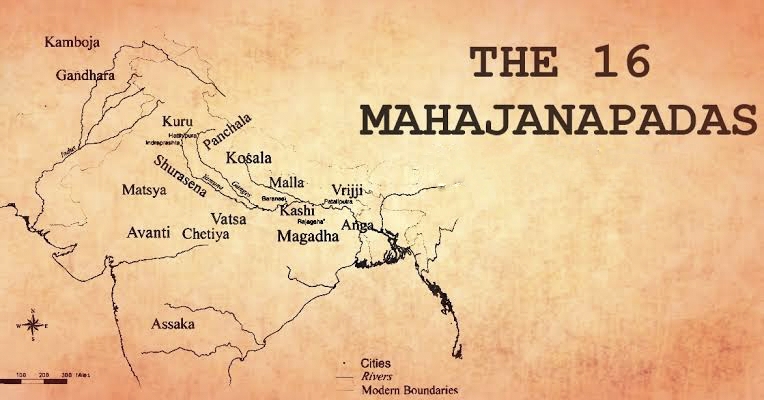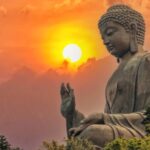| 16 Mahajanapadas (Modern Area) | Capital | |
| 1 | Anga (districts of Munger and Bhagalpur in Bihar) | Champa/Champanagari |
| 2 | Magadha (districts of Patna, Gaya and Nalanda in Bihar) | Girivraj, Rajgriha/ Rajgir (Bimbisara), Patliputra (Udayin), Vaishali (Shishunaga), Patliputra (Kalashok) |
| 3 | Vajji (districts of Muzaffarpur & Vaishali in Bihar) | Vldeha, Mithila, Vaishali |
| 4 | Malla (districts of Deoria, Basti, Gorakhpur and Siddharthnagar in U.P,) | Kuishinara and Pawa |
| 5 | Kashi (district of Varanasi in U.P.) | Varanasi |
| 6 | Kosala (districts of Faizabad, Gonda, Bahraich in U.P.) | North Kosal-Sravasti/Sahet-Mahet South Kosal-Saket /Ayodhya |
| 7 | Vatsa (districts of Allahabad, Mirzapur in U.P.) | Kausambi |
| 8 | Chedi (Bundelkhand area) | Shaktimati / Sotthivati |
| 9 | Kuru (Haryana and Delhi area) | Indraprastha (modern Delhi) |
| 10 | Panchala (Ruhelkhand, Western U.P.) | North Panchal-Ahichhatra South Panchal-Kampilya |
| 11 | Shurasena (Brajmandal) | Mathura |
| 12 | Matsya (Alwar, Bharatpur and Jaipur in Rajasthan) | Viratnagar |
| 13 | Avanti (Malwa) | North Avanti-Ujjayini South Avanti-Mahishmati |
| 14 | Ashmaka (between the rivers Narmada and Godavari) | Potana / Patali |
| 15 | Gandhara (western part of Pakistan and Afghanistan) | Taxila (near Rawalpindi, Pakistan)and Pushkalavati |
| 16 | Kamboja (Hazara district of Pakistn) | Rajapur/Hataka |
>> Buddhist literature (Anguttara Nikaya, Mahavastu) and Jain literature (Bhagavati Sutta) present a list of 16 Mahajanapadas (i.e., great states) with minor variation of names.
Rise of Magadha
>> The political history of India from 6th century BC onwards is the history of struggle between four states—Magadha, Kosala, Vatsa and Avanti for supremacy.
>>Ultimately the kingdom of Magadha emerged to be the most powerful one and succeeded in founding an empire.
Reason of Magadha’s success
1. Magadha enjoyed an advantageous geographical position in the age of iron, because the richest iron deposits were situated not far away from Rajgir, the earliest capital of Magadha and could be used for making weapons and implements. Iron axes were perhaps useful in clearing the thick forests, and iron-tipped plough-shares ploughed the land better and helped to increase grain production.
2. Magadha lay at the centre of the middle Gangetic plain. The alluvium, once cleared of the jungles, proved immense fertile and food surplus was thus available.
3. Magadha enjoyed a special advantage in military organisation. Although the Indian states were well acquainted with the use of horses and chariots, it was Magadha which first used elephants on a large scale in its war against its neighbours.
Haryanaka Dynasty : 544 BC-412 BC
Bimbisara (Shronika) : 544 BC-492 BC
>> Founder of Haryanka dynasty.
>> Magadha came into prominence under the leadership Of Bimbisara.
>> He was a contemporary of Gautama Buddha.
>> He married the princesses of Kosala (Kosaldevi/ Mahakosa-sister of Kosal King Prasenjit), Lichchhavi (Chellana-sister of Lichchhavi Head Chetaka) and Madra (Khema-daughter of Madra king), which helped him in his expansionist policy.
>> He gained a part of Kashi as the dowry in his marriage with the sister of king Prasenjit of Kosala.
>> He conquered Anga.
>> Known as Seniya, he was the first Indian king who had a regular and standing army.
>> He built the city of New Rajagriha.
Ajatashatru (Kunika) : 492 BC-460 BC
>> Bimbisara was succeeded by his son Ajatashatru. Ajatashatru killed his father and seized the throne.
>> Ajatashatru followed a more aggressive policy. He gained complete control over Kashi and broke the earlier amicable relations by attacking his maternal uncle Prasenjit, the king of Kosala.
>> The Vajji confederation was Ajatashatru’s next target of attack. This war was a lengthy one and tradition tells us that after a long period of 16 years, he was able to defeat the Vajji only through deceit, by sowing the seeds of discord amongst the people of Vajji.
>> The three things that played important role to defeat the Vajji-1.Sunidha and Vatsakar– Ajatashatru’s diplomatic ministers, who sowed the seeds of discord amongst Vajjis, 2. Rathamusala– a kind of chariot to which a mace was attached 3. Mahashilakantaka -a war engine which catapulted big stones.
>> In this way Kashi and Vaishali (the capital of Vajji) were added to Magadha, making it the most powerful territorial power in the Ganges Valley.
>> He built the fort of Rajagriha and a watch-fort (Jaladurga) at a village called Patali, on the banks of the Ganges.
Udayin : 460 BC-440 BC
>> Ajatshatru was succeeded by his son Udayin.
>> His reign is important because he laid the foundations of the city of Patliputra at the confluence of the Son and the Ganges and shifted the capital from Rajagriha to Patliputra.
>> Udayin was succeeded by Anuruddha, Munda and Naga-Dasak respectively who all were weak and parricides.
Shisunaga Dynasty: 412 BC-344 BC
>> Nag-Dasak was unworthy to rule. So the people got disgusted and elected Shisunaga as the King, the minister of the last king.
>> The most important achievement of Shisunaga was the destruction of the Pradyota dynasty of Avanti. This brought to an end the hundred year old rivalry between Magadha and Avanti. From then on Avanti become a part of the Magadha rule.
>> Shisunaga was succeeded by Kalashoka (Kakavarna). His reign is important because he convened the Second Buddhists Council in Vaishali (383 BC).
Nanda Dynasty: 344 BC-323 BC
>> The Shisunaga dynasty was overthrown by Mahapadma who established a new line of kings known as the Nandas.
>> Mahapadma is known as Sarvakshatrantak i.e. Uprooter of all the Kshatriyas (Puranas) and Ugrasena i.e. Owner of huge army (Pali texts).
>> The Puranas call Mahapadma Ekrat i.e. the sole monarch. He seems to have overthrown all the dynasties which ruled at the time of Shisungas. He is often described as ‘the first empire builder of Indian history’.
>> Mahapadma was succeeded by his eight sons. Dhanananda was the last one.
>> It was during the rule of Dhanananda that the invasion of Alexander took place in north-west India in 326 BC.
>> The Nanda dynasty came to an end about 322-21 BC and was supplanted by another dynasty known as Mauryas, with Chandragupta Maurya as the founder.
Foreign Invasions
- Iranian/Persian Invasion—Darius’s Invasion (518 BC)
>> The Achaemenian rulers of Iran (Persia , who expanded their empire at the same time as the Magadhan princes, took advantage of the political disunity on the North-West Frontier of India.
>> The Achaemenian ruler Darius I (Darayabahu) penetrated into North-West India in 518 BC and annexed Punjab, West of the Indus and Sindh. This area constituted the 20th province (Kshatrapi) of Iran, the total number of provinces in the Iranian empire being 28.
>> The Indo-Iranian contact lasted for about 200 years.
Effects of Iranian Invasion
1. It gave an impetus to Indo-Iranian trade and commerce.
2. Through the Iranian, the Greeks came to know about the great wealth of India and this eventually led to Alexander’s invasion of India.
3. The Iranian scribes brought into India a form of writing which came to be known as the Kharosthi script. It was written from right to left like the Arabic
Il. Macedonian Invasion—Alexander’s Invasion (326 BC)
>> In the 4th century BC, the Greeks and the Iranian fought for the supremacy Of the world. Under the leadership of Alexander of Macedonia the Greek finally destroyed the Iranian empire.
>>As a preliminary step to conquer India, the Kabul valley and the hilly area of North-West frontier were conquered, and he reached Ohind near Attock in 326 BC.
>> The rulers of Taxila and Abhisara submitted but Porus(Puru) refused to do so.
>> Alexander then crossed the Jhelum by a trick. Porus was defeated in the battle that followed, but Alexander treated him very generously for his bravery. (Battle of Vitasta i.e. modern Jhelum, Greek-Hydaspes – 326 BC).
>>This was how the Indians were defeated because of their disunity.
>> After a brilliant victory at Sakala, the Greek forces reached the Beas. Alexander had to return from this place as his soldiers refused to go any further. The battle of Jhelum and Sakla had opened their eyes and they were afraid of the great Magadhan empire across the Beas.
>> After making administrative arrangements for the conquered territory, Alexander marched back in Sep. 325 BC.
>> He reached Babylon in 323 BC where he died at the age of 33.
Featured image courtesy: iasgyan Vedic Culture



